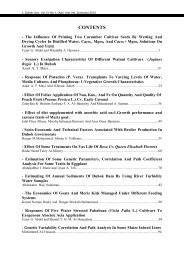Create successful ePaper yourself
Turn your PDF publications into a flip-book with our unique Google optimized e-Paper software.
J. Duhok Univ., Vol.14, No.1 (Pure and Eng. Sciences), Pp 9-16, 2011<br />
We only prove part(3), the proof of the other<br />
parts is obvious.<br />
Proof.(3). Let G be any cp-open set in X<br />
containing x, by Corollary 2.10,A is a cpneighborhood<br />
of x, this shows that x is a cpinterior<br />
of A. Hence x�cp-int(A), so x�G � cpint(A)<br />
� A. We get cp-int(A) contains all cpopen<br />
subset of A and it is therefore, the largest<br />
cp-open subset of A.<br />
In general cp-int(A) � cp-int(B) � cpint(A<br />
� B), and cp-int(A � B) � cp-int (A) � cpint(B)<br />
as shown by the following two examples:<br />
Example 2.13. Let X={a, b, c, d} with topology<br />
� ={ � , X, {c}, {a, d}, {a, c, d}} Take A={a, d}<br />
and B={b, c}. cp-int(A � B)=X cp-int(A)={a,<br />
d}and cp-int(B)={c}, so cp-int(A) � cpint(B)<br />
� cp-int(A � B)<br />
Example 2.14. Let X={a, b, c, d} and � = { � ,<br />
X,{a, b}, {a, b, c}}. Take A={b, c} and B={a, c,<br />
d}, then A � B={c}, cp-int(A � B)= � but cpint(A)={b,<br />
c} and cp-int(B)={a, c, d}. So cpint(A)<br />
� cp-int(B)={b} and hence cp-int(A � B)<br />
� cp-int(A) � cp-int(B) .<br />
It follows that, cp-int (A)=cp-int(B) does not<br />
imply that A=B. This is shown by Example 4.9<br />
in [12].<br />
Definition 2.15. Let A be a subset of a<br />
topological space(X, � ). A point x�X is said to<br />
be a cp-limit point of A if every cp-open set<br />
containing x contains a point of A different from<br />
x. The set of all cp-limit points of A is called cpderived<br />
set and denoted by cp-d(A).<br />
Lemma 2.16. Let A be a subset of a topological<br />
space (X, � ). A is cp-closed if and only if A<br />
contains all of its cp-limit points.<br />
Proof. Assume that A is cp-closed set and let p<br />
is a cp-limit point of A which belongs to X\A.<br />
Then X\A is a cp-open set containing the cplimit<br />
point of A. Therefore, we get X\A contains<br />
an element of A which is contradiction.<br />
Conversely. Assume that A contains all of its<br />
cp-limit points. For each x�X\A there exists a<br />
cp-open set U containing x such that U � A= � ,<br />
that is, x�U � X\A, by Theorem 2.9, X\A is a<br />
cp-open set. Hence A is a cp-closed set.<br />
Some properties of cp-derived set are<br />
mentioned in the following results:<br />
Proposition 2.17. For any subsets A and B of a<br />
topological space X, then we have the following<br />
properties.<br />
1. If A � B, then cp-d(A) � cp-d(B),<br />
2. x�cp-d(A) implies x�cp-d(X\A),<br />
3.cp-d(A) � cp-d(B) � cp-d(A � B),<br />
4.cp-d(A � B) � cp-d(A) � cp-d(B).<br />
Proof. (3) and (4) follow from (1).<br />
The equality does not hold in (3) and (4) as<br />
shown by Examples 4.12 and 4.13 in [12].<br />
Definition 2.18. The intersection of all cp-closed<br />
sets containing A is called the cp-closure of A<br />
and it is denoted by cp-cl(A).<br />
Here we give some properties of cp-closure<br />
of the set.<br />
Proposition 2.19. For any subset E and F of a<br />
topological space X. The following statements<br />
are true.<br />
1. E� cp-cl(E),<br />
2. cp-cl(E) is cp-closed set in X containing E,<br />
3. cp-cl(E) is the smallest cp-closed set<br />
containing E,<br />
4. E is cp-closed if and only if cp-cl(E)=E, then<br />
cp- cl(cp-cl(E)) =cp-cl(E),<br />
5.If E� F, then cp-cl(E) � cp-cl(F),<br />
6.cp-cl(A) � cp-cl(B) � cp-cl(A � B),<br />
7.cp-cl(A � B) � cp-cl(A) � cp-cl(B).<br />
Generally, equality in (6) and (7) does not<br />
holds as shown by Examples 4.22 and 4.23 in<br />
[12].<br />
Icp-cl(A)=cp-cl(B) does not imply A=B this is<br />
shown in Example 4.18 in [12].<br />
Theorem 2.20. Let X be a space and A be any<br />
subset of X, then A � cp-d(A) is cp-closed.<br />
Proof. Let x�A � cp-d(A). This implies that<br />
x�A and x�cp-d(A). Since x�cp-d(A) there<br />
exists a cp-open set G x of x which contains no<br />
point of A other than x but x�A. So G x<br />
contains no point of A, which implies<br />
G is a cp-open set of each<br />
G x � X\A. Again x<br />
of its points. But G x does not contain any point<br />
of A, no point of G x can be a cp-limit point of<br />
A. Then no point of G x can belong to cp-d(A),<br />
so G x � X\cp-d(A) implies<br />
x� x<br />
G � X\A � X\cp-d(A) = X\(A � cp-d(A)),<br />
by Theorem 2.9, X\(A � cp-d(A)) is a cp-open<br />
set, so A � cp-d(A) is a cp-closed set.<br />
Corollary 2.21. For any subset A of a<br />
topological space X. we have cp-cl(A) =A � cpd(A).<br />
Proof. Since by Theorem 2.20, A � cp-d(A) is<br />
cp-closed containing A and cp-cl(A) is the<br />
smallest cp-closed containing A implies that cpcl(A)<br />
� A � cp-d(A). Hence cp-cl(A) =A � cpd(A).<br />
11



